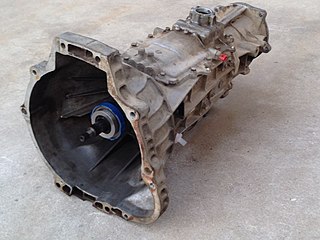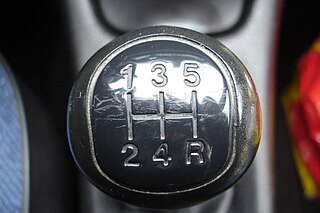A millisecond is a unit of time in the International System of Units equal to one thousandth of a second and to 1000 microseconds.

An automatic transmission is a multi-speed transmission used in motor vehicles that does not require any input from the driver to change forward gears under normal driving conditions. Vehicles with internal combustion engines, unlike electric vehicles, require the engine to operate in a narrow range of rates of rotation, requiring a gearbox, operated manually or automatically, to drive the wheels over a wide range of speeds.

A transmission is a mechanical device which uses a gear set—two or more gears working together—to change the speed or direction of rotation in a machine. Many transmissions have multiple gear ratios, but there are also transmissions that use a single fixed-gear ratio.

A manual transmission (MT), also known as manual gearbox, standard transmission, or stick shift, is a multi-speed motor vehicle transmission system, where gear changes require the driver to manually select the gears by operating a gear stick and clutch.
A semi-automatic transmission is a multiple-speed transmission where part of its operation is automated, but the driver's input is still required to launch the vehicle from a standstill and to manually change gears. Semi-automatic transmissions were almost exclusively used in motorcycles and are based on conventional manual transmissions or sequential manual transmissions, but use an automatic clutch system. But some semi-automatic transmissions have also been based on standard hydraulic automatic transmissions with torque converters and planetary gearsets.
The modern usage of the automotive term manumatic denotes an automatic transmission that allows the driver to select a specific gear, typically using paddle-shifters, steering wheel-mounted push-buttons, or "+" and "-" controls on the gear selector.

A direct-shift gearbox is an electronically controlled, dual-clutch, multiple-shaft, automatic gearbox, in either a transaxle or traditional transmission layout, with automated clutch operation, and with fully-automatic or semi-manual gear selection. The first dual-clutch transmissions were derived from Porsche in-house development for the Porsche 962 in the 1980s.

A preselector gearbox is a type of manual transmission mostly used on passenger cars and racing cars in the 1930s, in buses from 1940–1960 and in armoured vehicles from the 1930s to the 1970s. The defining characteristic of a preselector gearbox is that the gear shift lever allowed the driver to "pre-select" the next gear, usually with the transmission remaining in the current gear until the driver pressed the "gear change pedal" at the desired time.

The automated manual transmission (AMT) is a type of transmission for motor vehicles. It is essentially a conventional manual transmission equipped with automatic actuation to operate the clutch and/or shift gears.
Sequential transmission may refer to:

A gear stick, gear lever, gearshift or shifter, more formally known as a transmission lever, is a metal lever attached to the transmission of an automobile. The term gear stick mostly refers to the shift lever of a manual transmission, while in an automatic transmission, a similar lever is known as a gear selector. A gear stick will normally be used to change gear whilst depressing the clutch pedal with the left foot to disengage the engine from the drivetrain and wheels. Automatic transmission vehicles, including hydraulic automatic transmissions, automated manual and older semi-automatic transmissions, like VW Autostick, and those with continuously variable transmissions, do not require a physical clutch pedal.
Shift time refers to the time interval between gear changes in a transmission. This interval is the time in which power delivery is transferred to the next selected gear, and engine speed is reduced or increased to synchronize the speed of the next gear. Shift time is usually in reference to motor vehicles, but can apply to any gearbox.
Easytronic is the Opel tradename for a type of transaxle-based automated manual transmission or gearbox, as used in some Opel/Vauxhall cars.

Selespeed is the name of an automated manual transmission used in Alfa Romeo cars, developed by Italian company Magneti Marelli and made by Graziano Trasmissioni.
The 1941 M4 Vacamatic transmission by Chrysler was, historically, the first semi-automatic transmission which was marketed by a major manufacturer. It was an attempt to compete against rivals' hydraulic automatic transmissions, though it still had a clutch, primarily to change range. In normal driving, the clutch is not used. The transmission itself was a fully-synchronized manual transmission, with four forward gears, one reverse; where the shifting was done 'automatically' by either vacuum cylinders, or hydraulic cylinders. The main difference was the addition of a fluid coupling between engine and clutch, and the shifting mechanism.
Twin Clutch SST is the brand name of a six-speed dual-clutch automatic transmission, developed by Getrag for Mitsubishi Motors. The system was first incorporated in the 2008 Lancer Evolution X, and was designed to be a more performance-oriented system than that developed by rival manufacturers, with shorter gear ratios optimized for acceleration.

A MultiMode manual transmission is a type of automated manual transmission offered by Toyota. It uses a traditional manual gearbox with a computer-controlled clutch actuated by permanent magnet motors. Multimode Manual Transmission is available in the Aygo, Yaris, Corolla, Corolla Verso, Mark X and Auris in Europe, and should not be confused with Multimode Automatic Transmission, which is offered in the North American market by Toyota.

A dual-clutch transmission (DCT) is a type of multi-speed vehicle transmission system, that uses two separate clutches for odd and even gear sets. The design is often similar to two separate manual transmissions with their respective clutches contained within one housing, and working as one unit. In car and truck applications, the DCT functions as an automatic transmission, requiring no driver input to change gears.

A motorcycle transmission is a transmission created specifically for motorcycle applications. They may also be found in use on other light vehicles such as motor tricycles and quadbikes, go-karts, offroad buggies, auto rickshaws, mowers, and other utility vehicles, microcars, and even some superlight racing cars.
The Dacia Easy-R is an automated manual transmission used by Renault and Dacia that uses electro-mechanical actuation to automate the gear shifts. The Easy-R uses a traditional manual gearbox with a computer-controlled, electronic clutch; the gear shifts are automatic, and the need for a clutch pedal is eliminated. The number of parts has been reduced by a quarter, ensuring better reliability and simplified maintenance.









